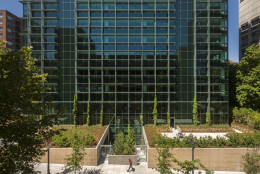Green Buildings
-
In the future, federal offices could be more like patios - where furniture is adjustable and moveable for whatever task or project is at hand, say experts at the General Services Administration. In our special report, The Federal Office of the Future, we examine the research behind the decision to make office spaces more flexible.
July 16, 2015 -
Eco-friendly construction is a priority, and in some cases a requirement. for future office planning in the federal government. Federal News Radio's special report, The Federal Office of the Future, explores how LEED certification standards are sweeping the country in new and current federal offices.
July 15, 2015 -
After a four-year renovation, the Edith Green-Wendell Wyatt (EGWW) Federal Building is a model of success for the green construction movement. The building now uses about half as much energy as it previously did and 60 percent less water than typical office buildings. Federal News Radio goes inside the building in part 2 of our special report, The Federal Office of the Future.
July 15, 2015 -
Simply ensuring offices have views to the outside, contain plants, receive adequate daylight or have nature-inspired art all help create a more inviting, healthy environment. Bill Browning offers tips on making your office a more productive place for employees by bringing the outside in.
July 14, 2015 -
In a recent executive order, President Barack Obama called on agencies to reduce greenhouse gas emissions. Thomas Day, the Postal Service's chief sustainability officer, joined Tom Temin on the Federal Drive to explain the steps the agency is taking on doing just that.
March 30, 2015 -
By JOSH LEDERMAN Associated Press WASHINGTON (AP) — President Barack Obama ordered the federal government on Thursday to cut its greenhouse gas emissions by nearly half over the next decade, driving his climate change agenda…
March 20, 2015 -
The National Park Service is putting in place 81 energy efficiency and water conservation projects in parks throughout the D.C. metropolitan area. Lisa Mendelson is the Acting Regional Director for the National Capital Region at the National Park Service. She joined Tom Temin on the Federal Drive with details the scope of the project that will install new intelligent bulbs, sprinklers and solar power across the region's hundreds of parks and landmarks in 2015.
December 04, 2014 -
Green investments to federal buildings are showing double-digit energy savings, according to the General Services Administration. They're looking at the effects of some energy upgrades. Ruth Cox is a senior sustainability official, and Walter Tersch is a program analyst at the General Services Administration. On In Depth with Francis Rose, they broke down the success of the green updates.
November 12, 2014 -
The government wants to go green and it's soliciting employee suggestions to help do it. It's a top-to-bottom effort though, as federal agencies also released their annual sustainability plans and the President announced a new GreenGov Symposium.
November 04, 2014 -
By the end of next year, the Army will install advanced electric meters at most of its large buildings, giving the service much more detailed data on how it uses energy than it's ever seen before.
October 23, 2014 -
The Army says the alternative and renewable energy industry should not look to the military as a giant source of investment capital for new technologies. But there are a few exceptions to that rule.
August 01, 2014 -
Agencies released sustainability scorecards showing progress toward green goals. Overall, agencies have exceeded goals and reduced greenhouse gases, pollution and waste and increased renewables.
July 28, 2014 -
The General Services Administration's Net-Zero Energy Task Group is planning to produce a draft letter with clear goals and guidance for net-zero energy buildings by this September.
July 10, 2014 -
The U.S. Postal Service is looking at greener, more efficient vehicle options while waiting for funds to replace its outdated fleet.
June 30, 2014 -
The Postal Service's mail delivery vehicles are in dire need of replacement, but the agency doesn't have enough money to buy a new fleet. In a new report, the USPS Inspector General said the agency's current fleet will only allow it to sustain delivery operations through fiscal 2017.
June 17, 2014






